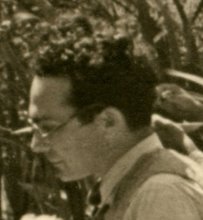
 Jan Lukasiewicz (Biography from the MacTutor History of Mathematics archive)
Jan Lukasiewicz (Biography from the MacTutor History of Mathematics archive)Jan Lukasiewicz (Short biography from Wikipedia)
Jan Lukasiewicz
Jan Lukasiewicz
Jan Lukasiewicz - Wikipedia
*
Monteiro descubrió que las álgebras de Nelson semisimples son precisamente las álgebras de Lukasiewicz trivalentes, que habían sido introducidas y estudiadas por Grigore G. Moisil a partir de 1940. Anunció este resultado en una comunicación a la Unión Matemática Argentina en octubre de 1962 (Revista de la Unión Matemática Argentina y de la Asociación Física Argentina, 21 (l 963), 145-146), pero nunca publicó la demostración. La demostración original de Monteiro, tal como se encontraba en sus archivos personales, fue editada por su hijo Luiz y publicada en [M45].
Monteiro [M30], [M35], utilizando propiedades de las álgebras de Nelson, demuestra que las álgebras de Lukasiewicz trivalentes pueden representarse en las álgebras de Boole monádicas. Este resultado algebraico tiene una importante interpretación lógica: el cálculo trivalente de Lukasiewicz puede modelarse en la lógica monádica clásica. En este sentido, es el análogo del procedimiento clásico para probar la consistencia relativa de una geometría no euclidiana: construir un modelo de la misma dentro de la geometría euclidiana.
[De] Roberto Cignoli: La Obra Matemática de António Monteiro.
*
Throughout the study of Boolean and Heyting algebras, Monteiro became interested in the algebraic aspects of logic, this interest having been aroused by direct contact with Roman - Sikorski and Helena Rasiowa when they visited Bahía Blanca in 1958. Monteiro applied his mathematical experience to the study of algebraic systems related to non-classical logics. He was convinced that the algebraic methods in logic would have important technological applications in the future, as a consequence of the development of computers. In view of such prospective applications, he tried to use finitistic and combinatorial methods in studying classes of algebras, whenever possible.
Given a class of algebras K, it was a basic problem for him to decide if the finitely generated free algebras in K were finite, and if so, to find explicitly the number of its elements as a function of the number of free generators. In general, to achieve this goal it is necessary to have a deep understanding of the structure of the algebras in K. As an example, let me reproduce the formula giving the number of elements Ln(r) of the free algebra with r free generators in the class Kn corresponding to the n-valued Lukasiewicz propositional calculus (n an integer >2). Here, D is the set of divisors of n-1, M(d) is the set of maximal divisors of d, L denotes- the greatest common divisor and X is the number of elements of X:
 This formula was obtained by Monteiro in 1969, solving in this way a problem which was open since 1930.
This formula was obtained by Monteiro in 1969, solving in this way a problem which was open since 1930.In the same vein, he determined the structure of the finite De Morgan and Nelson algebras. Monteiro investigated in depth the structure of Nelson algebras (introduced by H. Rasiowa as the algebraic counterparts of the constructive logic with strong negation considered by Nelson and Markhoff), and he proved that the class of semi-simple Nelson algebras coincides with the class of algebras corresponding to three-valued Lukasiewicz logics. Thus he showed that, from the algebraic point of view, the three-valued Lukasiewicz logic stands in the same relation to constructive logic with strong negation as classical logic does to intuitionistic logic.
Monteiro also proved that each three-valued Lukasiewicz algebra can be rep-resented as a suitable monadic Boolean algebra. He liked this result very much, because it meant that Lukasiewicz three-valued propositional calculus had an interpretation in the classical monadic functional calculus. This results is analogous to the construction of Euclidean models of non-Euclidean geometry.
[De] Roberto Cignoli: Antonio Monteiro, 1907-1980.




